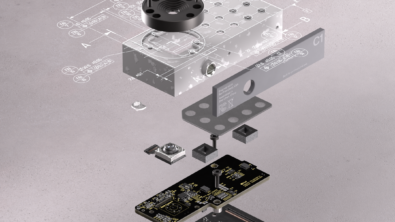Preparing students for careers in mechanical engineering with NX CAD

There is a significant discrepancy between how academia prepares students and what the industry expects them to do when they graduate. To close that gap, new design and manufacturing techniques must be introduced to students as early as possible. Academia should also strive to ensure students are being taught how to use the tools currently used by prospective employers.
On this episode of the Next Generation Design podcast, our host Jennifer Piper talks to Leah Griesmer, a third-year mechanical engineering student at the University of Cincinnati (UC). Leah has an interest in additive manufacturing and 3D modeling and plans to get into product design after graduation.
In this episode, you will learn about the benefits of learning CAD software, specifically NX CAD before entering the workforce. You will also get to hear about Leah’s positive experience with NX highlighting its user-friendly interface, CAE capabilities, and seamless integration with other CAD software. Additionally, you will find Leah’s insights as she provides valuable perspectives for aspiring designers and highlights the exciting possibilities in the world of product design.
Listen to or read the full episode: A Student’s Journey in CAD and 3D Modeling
Check out a Professor’s perspective: University of Cincinnati prepares students for engineering careers by teaching NX CAD
What you’ll learn in this episode:
Introduction to product design
Leah was first introduced to product design in high school in an engineering CAD class. The students were given different design prompts and then had to design them in CAD. For example, they designed balsa wood bridges, airplanes, or cars. Leah became fascinated with the design process and decided to join her high school robotics team, where she and her teammates would design robots to compete in different games. While she didn’t always know that she wanted to go into product design, she knew she wanted to do something with engineering. Whether it was her high school robotics team, or Lego Mindstorm camps, or Camp Invention as a kid, she knew she had an interest in designing and being hands-on. With all of those experiences under her belt, she chose to go to the University of Cincinnati for mechanical engineering, and she is currently a Mechanical Engineering Co-Op at TREW Automation on the product development team.
The University of Cincinnati product design courses
In Leah’s first year at the University of Cincinnati, she took a freshman engineering course called ENED. In a project for this course, students pick a local humanitarian issue to tackle. Leah’s group chose to do something that would help homeless people with comfortable sleeping accommodations. For their project, they designed a memory foam portable sleeping bag that helps with back pain when having to sleep outdoors.
In addition to ENED, Leah also took a 3D foundations course her freshman year. The University of Cincinnati has a partnership with Siemens Digital Industries Software that established the UC-Siemens Simulation Technology Center in 2016. Through this partnership, the entire Siemens Xcelerator platform is available to students, including NX which is introduced to mechanical engineering students in their first year. For one project using NX, students reverse engineer an item of their choice through taking the physical item apart and measuring the components, then modeling it with NX 3D CAD software. With a few years of courses and a couple co-ops under her belt, Leah looks forward to her senior capstone project which will include a full-on product design experience.
The product design process
Leah says the most important thing to do to begin the design process is to talk to who gave you the design concept and figure out their goal and problem they’re trying to solve. Then, you need to find out what design specifications there are to solve that problem. You need to answer questions like: how big does it need to be, what type of materials can be used, does it need to be waterproof, what are the cost restrictions, etc. You want to design a product that solves the problem, but you want to do it efficiently and cost-effectively. Then, Leah says she enters the brainstorming phase which consists of sketching or doing different 3D model concepts in CAD. From there, she will talk to whoever is in charge of the final design, get their input, and do design iterations from there.
Benefits of creating a digital mockup
Leah notes how helpful 3D modeling is with CAD software such as NX because she is a very multi-dimensional thinker and not the best at sketching after the initial design. With 3D modeling, she can mold the product digitally, look at it in different views, add and remove components, see parts in the digital realm, and work out kinks before physically producing a prototype. When there’s a final product after all the design phases, there will be less refinement to do because of the ability to make edits to the 3D digital model.
In terms of 3D modeling software, Leah has personally worked with SolidWorks, Fusion 360, and Siemens’ NX CAD. She says that a lot of these programs not only allow you to 3D model the product you’re building but also run stress analysis tests, determine how much it is going to weigh, put parts together in an assembly, do an animation of moving parts, find weak points in the assembly, and more. With these tests in the digital realm, the prototype can be as close to the final model as it can which saves time and money.
Experience with Siemens’ NX CAD
The University’s partnership through being an academic partner allows students to have access to the Siemens Xcelerator software needed for assignments. Leah had NX on her personal laptop and also used it in a classroom setting. Because of her previous 3D modeling experience with Fusion 360 in high school, she picked up NX very quickly and found it to be nearly seamless to make the switch. It was a matter of learning where the different buttons were, and then it was quick and easy to learn. For Leah’s freshman final reverse engineering project, her group did a Nerf gun. They took it apart, looked at the mechanical parts, designed them in NX, and put them all back together in a digital 3D assembly as well as show how it moved. “It was a great experience,” she says, “I was able to easily share files with my teammates, and we could work together to make one final overall assembly.”
Though Leah found it seamless to pick up NX, she also had a textbook for her class that had many materials to teach 3D modeling and NX— noting specifically that it was very helpful for learning standard dimensioning and tolerances used in the industry. She also utilized YouTube and went to her professor’s office hours if she had questions throughout the process.
When asked how NX has benefitted her design process, Leah emphasizes the CAE capabilities within the software. When exploring motors in her 3D foundations class, she was able to see how much stress was going on the motor depending on how much torque it was using. It was fascinating to learn and see the CAE tests in action because she had not run tests like that in the past and found it easy plug in information and get results.
The podcast concludes with asking about Leah’s future plans. Her dream job after college is working at a toy company, designing toys for kids. It is the perfect mix between imaginative and complex designing. We wish Leah luck on the rest of her years at the University of Cincinnati and future career!
Want to learn more about NX CAD software? Check out our website or learn more about NX student resources.


